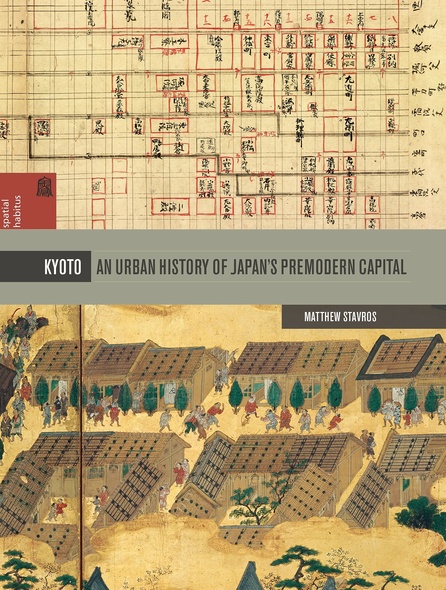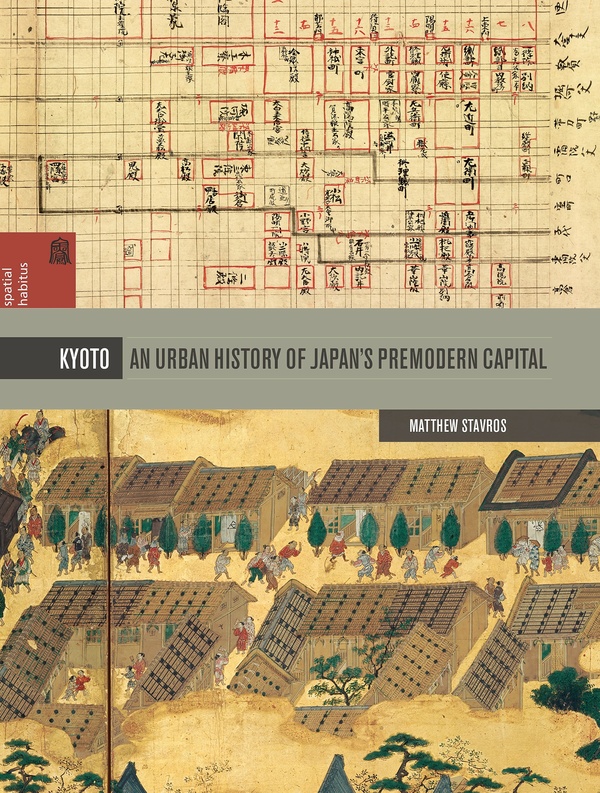
Kyoto
An Urban History of Japan's Premodern Capital
Kyoto was Japan’s political and cultural capital for more than a millennium before the dawn of the modern era. Until about the fifteenth century, it was also among the world’s largest cities and, as the eastern terminus of the Silk Road, it was a place where the political, artistic, and religious currents of Asia coalesced and flourished. Despite these and many other traits that make Kyoto a place of both Japanese and world historical significance, the physical appearance of the premodern city remains largely unknown. Through a synthesis of textual, pictorial, and archeological sources, this work attempts to shed light on Kyoto’s premodern urban landscape with the aim of opening up new ways of thinking about key aspects of premodern Japanese history.
The book begins with an examination of Kyoto’s highly idealized urban plan (adapted from Chinese models in the eighth century) and the reasons behind its eventual failure. The formation of the suburbs of Kamigyō and Shimogyō is compared to the creation of large exurban temple-palace complexes by retired emperors from the late eleventh century. Each, it is argued, was a material manifestation of the advancement of privatized power that inspired a medieval discourse aimed at excluding “outsiders.” By examining this discourse, a case is made that medieval power holders, despite growing autonomy, continued to see the emperor and classical state system as the ultimate sources of political legitimacy. This sentiment was shared by the leaders of the Ashikaga shogunate, who established their headquarters in Kyoto in 1336. The narrative examines how these warrior leaders interacted with the capital’s urban landscape, revealing a surprising degree of deference to classical building protocols and urban codes. Remaining chapters look at the dramatic changes that took place during the Age of Warring States (1467–1580s) and Kyoto’s postwar revitalization under the leadership of Oda Nobunaga and Toyotomi Hideyoshi. Nobunaga’s construction of Nijō Castle in 1569 transformed Kyoto’s fundamental character and, as Japan’s first castle town, it set an example soon replicated throughout the archipelago. In closing, the book explores how Hideyoshi—like so many before him, yet with much greater zeal—used monumentalism to co-opt and leverage the authority of Kyoto’s traditional institutions.
Richly illustrated with original maps and diagrams, Kyoto is a panoramic examination of space and architecture spanning eight centuries. It narrates a history of Japan’s premodern capital relevant to the fields of institutional history, material culture, art and architectural history, religion, and urban planning. Students and scholars of Japan will be introduced to new ways of thinking about old historical problems while readers interested in the cities and architecture of East Asia and beyond will benefit from a novel approach that synthesizes a wide variety of sources.
For more on Kyoto: An Urban History of Japan’s Premodern Capital, visit www.kyotohistory.com.
In this book, Matthew Stavros makes a marvelous exploration for English-speaking readerships to access the premodern history of Kyoto, Japan’s political and cultural capital for about a millennium. The book is an enjoyable read and a panoramic overview of the premodern history of Kyoto’s spatial production. As a well-structured book including vivid historiographical maps, images and photographs, it will be useful for a wide readership. The book will no doubt find its way into museum, library or bookstore collections.
In this lively examination of the role Kyoto’s built environment plays in understanding Japanese history, Stavros (Univ. of Sydney, Australia) provides a wealth of well-chosen, enriching detail in a beautifully illustrated context of maps, diagrams, and images. . . . Online aids include chapter discussion questions and links to internal and external visual resources.
Stavros’s text makes an important contribution to English-language scholarship on both East Asian urbanism and premodern urban history. The combination of clear arguments enlivened with quotations from period accounts, extremely useful maps and explanatory diagrams, and the cogent summarization of the voluminous literature on Kyoto history makes this the rarest of academic works—a book at once accessible to undergraduates and resonant to specialists. Stavros reminds us of the complex relationship between urban ideals and shifting social realities: that the physical fabric of cities and architecture matter in ways that outlive their physical dissolution.
The book has many fine qualities. The writing is exceptionally clear, and the maps and color image reproductions are of the high quality one might expect of an art history volume. Through both his text and the accompanying illustrations, Stavros provides a thorough account of the decline of the city’s western half and its reconfiguration over time. His detailed descriptions of retired emperors’ compounds, the shift from an imperial palace to aristocratic sato-dairi (temporary palaces), and the initially restrained roles played by warriors are quite engaging. Perhaps most compelling is how he shows residents struggling to maintain the city’s sanctity and functional purity, even though ‘there was no such thing as a golden age for Kyoto. . . . Kyoto: An Urban History does much to help make the development of premodern Japan’s most important city more understandable. It presents a compelling narrative that will be of great interest not only to Japan studies scholars but also to those who investigate architecture and urban design around the world. The volume provides thorough explanations to account for the capital’s many changes over time and is a welcome addition to the literature.
His style is lucid, his language accessible, his structure compact and controlled, and he provides meticulous photographs, illustrations and maps throughout to aid and engage the reader—if only more academics would keep this in mind when publishing books. Kyoto: An Urban History of Japan’s Premodern Capital is more an examination of the evolving personality of the city than of the personalities that shaped it. . . . Stavros uncovers much about the city’s intricate layout, its Byzantine postal addresses, its architecture and the shrines and temples that encroach on it. Essential and enjoyable reading for anyone interested in this ancient city.
The book deals cogently with the changing boundaries of the capital precinct and its role in signifying exclusion on the basis of social rank with the use of spatial inclusivity as a means of defining roles and functions within the city. . . . This book provides with great clarity the link between concept and urban artefact as built, enabling the visitor to grasp the significance of places within the flow of historical sequence and place. Highly recommended.
This ambitious book gives a panoramic overview of Kyoto’s urban history, from the city’s foundation by Kanmu Tennō in the late eighth century up to the dawn of the early modern era in the sixteenth century. It constitutes the first monographic history of premodern Kyoto written in English since 1931 . . . Stavros’s Kyoto: An Urban History of Japan’s Premodern Capital is a welcome addition to the literature on premodern Japan and will be useful to students and scholars in the fields of institutional and architectural history, urban planning, and material culture studies. The illustrations and companion website also make the book a wonderful resource for lectures and seminars.
Kyoto: An Urban History of Japan’s Premodern Capital treats its subject in such a way that Kyoto comes alive as an organic entity that conditions politics, social relations, and cultural formations. The book’s merits are many: beautifully written, well researched, and conceptually sophisticated, it provides a strong foundation for understanding how Kyoto has arrived at its present state. Its demonstration of the complex continuities and discontinuities that characterize urbanism and city-form in the premodern versus modern periods in Japan establishes its relevance for scholars and students of both premodern and modern Japanese studies. I would be delighted to assign this book in seminar and lecture courses to undergraduates and graduates.
The city of Kyoto comes alive in Stavros’ comprehensive study, the enduring main character of an enthralling and thoroughly researched story. The author uses material culture, archaeology, and documentary evidence to great effect, but it is above all the book’s many maps, diagrams, and photographs that make the city more than just a backdrop to the narrative. The long endurance of Kyoto is acknowledged but complicated by the theme of constant change: the capital’s markets grew in some periods and shrank in others, while neighborhoods opened wide in peacetime and then closed up tight in response to the tides of war. Stavros proves that the city’s identity is hybrid and always in flux, seen in the repeated efforts of elites to appropriate Kyoto’s imperial past and its associated geography in the creation of new structures of culture and power.




